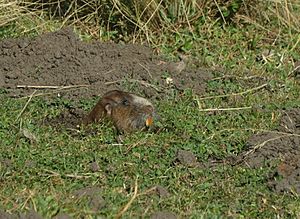Robust tuco-tuco facts for kids
Quick facts for kids Robust tuco-tuco |
|
|---|---|
 |
|
| Conservation status | |
| Scientific classification | |
| Genus: |
Ctenomys
|
| Species: |
tuconax
|
The robust tuco-tuco (its scientific name is Ctenomys tuconax) is a type of rodent. It belongs to a family of animals called Ctenomyidae. This small animal digs tunnels underground and lives only in the Tucumán Province of Argentina.
Contents
What Does a Robust Tuco-Tuco Look Like?
The robust tuco-tuco is a large kind of tuco-tuco. It can grow to be about 25.5 centimeters (10 inches) long. This measurement includes its tail, which is about 7.7 centimeters (3 inches) long.
Like other tuco-tucos, it has small eyes and ears. Its fur is very thick and soft. It also has big claws on its front feet, which help it dig. The fur on its body is brown. A darker, almost black, stripe runs down its back. Its belly is yellowish-brown, and its tail is light brown. Its feet have thin, whitish hairs.
Where Do Robust Tuco-Tucos Live?
This tuco-tuco lives only in the Tucumán Province in northwestern Argentina. It can be found in places as high as 3,000 meters (about 9,800 feet) above sea level. Scientists are not completely sure about its exact living area. However, it seems there are two separate groups of these animals.
Robust tuco-tucos like to live in wet, flat areas. They dig their homes in soil that is firm and rich in plant matter.
How Do Robust Tuco-Tucos Behave?
Tuco-tucos get their name from the sounds they make. They often call out "tuco-tuco" from the entrance of their burrows. They also make these sounds from deep underground.
These animals build amazing homes with many tunnels. Their burrows have special rooms for storing food. They also have a cozy chamber where they build their nests. Robust tuco-tucos usually live alone. They eat roots and different kinds of grasses.
What Is the Robust Tuco-Tuco's Status?
The robust tuco-tuco is listed as "data deficient" by the International Union for Conservation of Nature. This means that not enough is known about the animal. Scientists need more information to understand how many there are and if they are safe.
People say that this tuco-tuco is common in the northern part of its home area. However, its living spaces are being destroyed. This happens when land is cleared for farming. We do not know if the number of robust tuco-tucos is going up or down. But it is listed as a "vulnerable species" in Argentina. This means it could be at risk of disappearing if its habitat continues to be destroyed.
See also
 In Spanish: Ctenomys tuconax para niños
In Spanish: Ctenomys tuconax para niños


